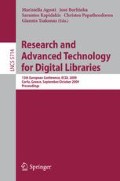Abstract
Query patterns enable effective information tools and provide guidance to users interested in posing complex questions about objects. Semantically, query patterns represent important questions, while syntactically they impose the correct formulation of queries. In this paper we address the development of query patterns at successive representation layers so as to expose dominant information requirements on one hand, and structures that can support effective user interaction and efficient implementation of query processing on the other. An empirical study for the domain of cultural heritage reveals an initial set of recurrent questions, which are then reduced to a modestly sized set of query patterns. A set of Datalog rules is developed in order to formally define these patterns which are also expressed as SPARQL queries.
Access this chapter
Tax calculation will be finalised at checkout
Purchases are for personal use only
Preview
Unable to display preview. Download preview PDF.
References
Andrenucci, A., Sneiders, E.: Automated Question Answering: Review of the Main Approaches. In: Proc. of the 3rd IEEE International Conference on Information Technology and Applications (ICITA 2005), Sydney, Australia (2005)
Bayardo, R.J.: Efficiently mining long patterns from database. In: Proc. of the 1998 ACM SIGMOD Conference, Seattle, USA (1998)
Bloehdorn, S., Cimiano, P., Duke, A., Haase, P., Heizmann, J., Thurlow, I., Völker, J.: Ontology-Based Question Answering for Digital Libraries. In: Kovács, L., Fuhr, N., Meghini, C. (eds.) ECDL 2007. LNCS, vol. 4675, pp. 14–25. Springer, Heidelberg (2007)
Borgelt, C., Berthold, M.: Mining Molecular Fragments: Finding Relevant Substructures of Molecules. In: Proc. of the 2002 ICDM Conference, Japan (2002)
Clark, P., Chaudhri, V., Mishra, S., Thoméré, J., Barker, K., Porter, B.: Enabling domain experts to convey questions to a machine: a modified, template-based approach. In: Proc. of the K-CAP 2003 Conference, Florida, USA (2003)
Constantopoulos, P., Dritsou, V., Foustoucos, E.: Query Patterns: Foundation and Analysis. Technical Report AUEB/ISDB/TR/2008/01 (2008), http://195.251.252.218:3027/reports/TR_2008_01.pdf
Eiter, T., Ianni, G., Polleres, A., Schindlauer, R., Tompits, H.: Reasoning with Rules and Ontologies. In: Barahona, P., Bry, F., Franconi, E., Henze, N., Sattler, U. (eds.) Reasoning Web 2006. LNCS, vol. 4126, pp. 93–127. Springer, Heidelberg (2006)
Hao, T., Zeng, Q., Wenyin, L.: Semantic Pattern for User-Interactive Question Answering. In: Proc. of the 2nd International Conference on Semantics, Knowledge, and Grid, Guilin, China (2006)
Hu, H., Yan, X., Huang, Y., Han, J., Zhou, X.J.: Mining coherent dense subgraphs across massive biological networks for functional discovery. Bioinformatics 21(1), 213–221 (2005)
Jones, K.S.: Information Retrieval and Digital Libraries: Lessons of Research. In: Proc. of the 2006 International Workshop on Research Issues in Digital Libraries, Kolkata, India (2006)
Polleres, A.: From SPARQL to rules (and back). In: Proc. of the 16th International Conference on World Wide Web (WWW 2007), Alberta, Canada (2007)
Sato, H., Pramudiono, I., Iiduka, K., Murayama, T.: Automatic RDF Query Generation from Person Related Heterogeneous Data. In: Proc. of the 15th International World Wide Web Conference (WWW 2006), Scotland (2006)
Shenk, S.: A SPARQL Semantics Based on Datalog. In: Proc. of the 30th Annual German Conference on Artificial Intelligence, Osnabrück, Germany (2007)
Shrikant, R., Agrawal, R.: Mining quantitative association rules in large relational tables. In: Proc. of the 1996 ACM SIGMOD Conference, Quebec, Canada (1996)
Sneiders, E.: Automated Question Answering: Template-Based Approach. PhD thesis, Stockholm University, Sweden (2002)
Author information
Authors and Affiliations
Editor information
Editors and Affiliations
Rights and permissions
Copyright information
© 2009 Springer-Verlag Berlin Heidelberg
About this paper
Cite this paper
Constantopoulos, P., Dritsou, V., Foustoucos, E. (2009). Developing Query Patterns. In: Agosti, M., Borbinha, J., Kapidakis, S., Papatheodorou, C., Tsakonas, G. (eds) Research and Advanced Technology for Digital Libraries. ECDL 2009. Lecture Notes in Computer Science, vol 5714. Springer, Berlin, Heidelberg. https://doi.org/10.1007/978-3-642-04346-8_13
Download citation
DOI: https://doi.org/10.1007/978-3-642-04346-8_13
Publisher Name: Springer, Berlin, Heidelberg
Print ISBN: 978-3-642-04345-1
Online ISBN: 978-3-642-04346-8
eBook Packages: Computer ScienceComputer Science (R0)

